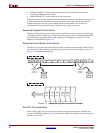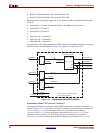
SPI-4.2 Lite v4.3 User Guide www.xilinx.com 81
UG181 June 27, 2008
Source Core
R
Transmitting Training Patterns
Training patterns are transmitted at startup (after reset) until the core acquires
synchronization on the FIFO Status Channel. Subsequently, if the parameter DataMaxT or
AlphaData are not zero, the core will transmit AlphaData training patterns at least every
DataMaxT cycles.
The core continuously monitors the number of data cycles since the transmission of the last
training pattern. Once a DataMaxT interval of SPI-4.2 bus cycles has completed, the
current transfer is terminated on the next burst boundary, and training patterns will be
transmitted on the SPI-4.2 bus (AlphaData number of times). Once the training patterns
have completed, the SPI-4.2 Lite core will resume transmission of data on the data bus.
The control signal TrainingRequest (see Table 2-11) is provided for you to request that
training patterns be sent out of the Source SPI-4.2 interface. When the TrainingRequest
signal is asserted, the transmission of data is halted on the next burst boundary and
training patterns are transmitted on the SPI-4.2 Interface.
If the static configuration signal AlphaData[7:0] (see Table 2-15) is set to zero, and the
TrainingRequest signal is asserted, the Source core will transmit a complete training
pattern sequence. The core will continue to transmit training patterns until
TrainingRequest is deasserted. When it is deasserted, the core will halt transmission of
training patterns after the current sequence is complete.
If the static configuration signal AlphaData[5:0] is set to a non zero value, the Source
core sends the number of training patterns defined by AlphaData every time it detects a
rising edge on the TrainingRequest signal.
Table 4-8: SPI-4.2 Control Word Mapping to 64-bit User Interface
Control Word
Associated SPI-4.2 Lite Control
Word bits on TDat (Qualified by
TCtl=1)
Associated Source FIFO Signal(s)
Start of Packet (SOP) TDat[15] =1, TDat[12]=1,
TDat[11:4] <== SrcFFAddr[7:0]
SrcFFSOP, SrcFFAddr[7:0]
New Burst (address change
without SOP)
TDat[15] = 1, TDat[12] = 0,
TDat[11:4] <== SrcFFAddr[7:0]
SrcFFAddr[7:0]
End of Packet
(EOP, even bytes valid)
TDat[14:13] = 10 SrcFFEOP, SrcFFMOD[2:0]
When TDat[14:13] = 10:
MOD = 000 if data bits 63-0 have valid data
MOD =110 if data bits 63-16 have valid data
MOD =100 if data bits 63-32 have valid data
MOD = 010 if data bits 63-48 have valid data
End of Packet
(EOP, odd bytes valid)
TDat[14:13] = 11 SrcFFWEOP & SrcFFWMod[2:0]
When TDat[14:13] = 11:
MOD = 111 if data bits 63-8 have valid data
MOD = 101 if data bits 63-24 have valid data
MOD = 011 if data bits 63-40 have valid data
MOD = 001 if data bits 63-56 have valid data
End of Packet
(EOP, abort, error condition)
TDat[14:13] = 01 SrcFFErr, SrcFFEOP,
SrcFFMOD[2:0]


















